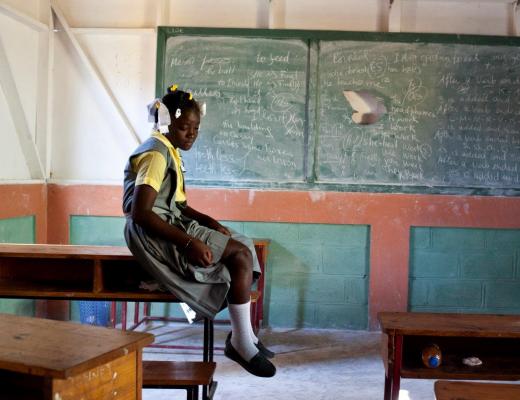 Haiti
Haiti
Languages
THE HAITIAN EARTHQUAKE FIVE YEARS ON – CHILDREN’S PSYCHOLOGICAL SCARS REMAIN

Although the catastrophic physical damage to housing, roads and public buildings wrought by the Haitian earthquake on 12 January 2010 is still visible, the psychological legacy that many young earthquake survivors are still struggling to live with is less easy to see with the naked eye.
Five years since the earthquake hit the tiny Caribbean island nation of Haiti, many children there still have limited access to education, and some report exposure to exploitation and sexual violence after the already-fragile country descended into chaos in the aftermath of the disaster. Many Haitian children still show signs of emotional and psychological stress, and remain in desperate need of assistance and protection today.
Their on-going distress, along with their hopes for a better future, is what Riccardo Venturi, World Press Photo award winner in 1997 and 2011, hoped capture while visiting Save the Children relief programmes in Haiti. Venturi’s resultant images are a humbling reminder to all involved in the rebuilding of Haiti that the international response to the disaster is far from complete.
Children who have lost one or both parents, are unaccompanied by a family member, or are still living in internally displaced persons (IDP) camps, are particularly at risk of exploitation, with sexual violence against minors in such settlements commonplace.
“I don’t feel safe here at all because people don’t respect each other. There are many cases of abuse,” says *Marie Darline, a 15-year-old girl who has been living in a sprawling Haitian IDP camp for four years.
She is one of more than 85,500 people are still living in temporary accommodation following the earthquake, more than half of which are children.
“If my mother and father were alive I would be protected. They wouldn’t let me live like this,” says Lovely*, a 14-year-old domestic worker living and working in Port-au-Prince.
Since the death of her parents in 2010, Lovely has been forced into casual domestic worker in order to survive, and is frequently beaten and mistreated. Sadly, Lovely’s story mirrors that of approximately 225,000 children aged between five and 17 who now find themselves at risk of being economically trapped into working as domestic child labourers, with little or no chance of escape from their dismal living conditions.
Lovely*, Marie*, and other children pictured in Venturi’s photo series, illustrate the fears and hopes for the future of Haitian children across the island.
“When I headed to Haiti in 2010 right after the earthquake I saw that fear and shock were particularly evident, most of all in children,” he says.
“But children have an incredible ability to smile and to live each day to its fullest. Haitian children are always full of positive energy, but today under the surface it is easy to see the signs of suffering and emotional stress they still experience because of the earthquake and because of the difficulties they encounter in their daily lives.
“Many of my images have tried to capture their look of veiled melancholy while always trying to keep their sense of dignity.”
Kevin Novotny, Country Director at Save the Children Haiti, says that Venturi’s portraits also show the children’s willingness to take a lead in being of the recovery progress, participating rather than passively coping with what doesn’t work for them.
“As Save the Children we encourage children to develop their own capabilities across all of our programmes in terms of education and protection. This approach also contributes to overall resilience of families and the community while building a better chance for the future.”
------------------------------
Notes to editors
The Haitian earthquake devastated the capital Port-au-Prince and neighbouring cities, where 230,000 lives were lost, nearly 400,000 homes and 5,000 schools were destroyed or damaged, and more than 1.6 million people were rendered homeless.
At the outset of the disaster, Save the Children initiated a multi-year recovery and development strategy reaching more than one million Haitian children and adults through earthquake relief and recovery programs including education, nutrition, clean water, sanitation, protection, and resiliency.
Save the Children is working with national child protection organisations in Haiti to raise awareness about child abuse and exploitation, and to promote children rights. Community-based partners are fighting against domestic abuse in some of the poorest neighbourhoods in the Port-au-Prince metropolitan area.
Riccardo Venturi ( www.riccardoventuri.com )was born in Rome in 1966. He started his career documenting Italian and European social issues like illegal immigration and the rising of Nazi movements in Germany, or the early years of democracy in Albania. In the mid 1990’s his attention was mainly drawn towards countries in conflict, foremost Afghanistan. Ever since, he has travelled to many countries at war among them Kosovo, Somalia, Gaza strip, Liberia, Sierra Leone, Libya. Over the last few years Riccardo Venturi has continued working with personal investigations and has often worked with international humanitarian agencies including Save the Children. He’s work has been exhibited and published worldwide in many respected publications including Time magazine, Newsweek, U.S. News, Business week, Philadelphia Enquirer, National Geographic, L'Express International, Le Nouvelle Observateur, Liberation, Der Spiegel, Stern, El Pais, Vanity Fair.